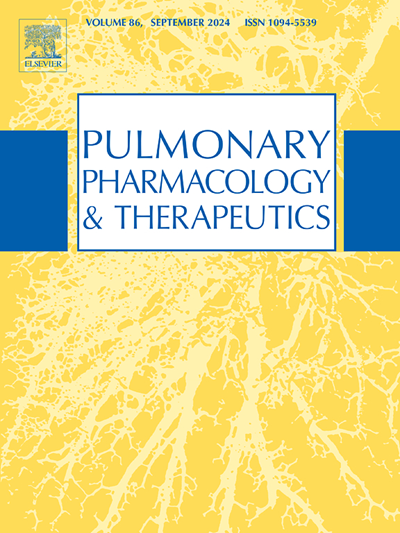Prevalence and clinical significance of pre- and post-bronchodilator airflow obstruction in COPD patients
IF 2.8
3区 医学
Q2 PHARMACOLOGY & PHARMACY
引用次数: 0
Abstract
Background
Chronic obstructive pulmonary disease (COPD) is a progressive respiratory disorder characterized by persistent airflow limitation. This study investigates the prevalence and clinical significance of pre-bronchodilator (PREO) and post-bronchodilator (POSTO) airflow obstruction in COPD.
Methods
This retrospective cohort study analyzed data from 3252 COPD patients aged ≥40 years, registered from January 2012 to December 2019 at 54 medical centers in South Korea. Patients were categorized into three groups: PREO & post-bronchodilator non-obstruction (POSTN), pre-bronchodilator non-obstruction (PREN) & POSTO, and PREO & POSTO. The primary outcome was moderate-to-severe exacerbation over 3 years. Secondary outcomes included GOLD group progression and rapid FEV₁ decline.
Results
The majority of patients (96.2 %) were in the PREO & POSTO group, with smaller proportions in the PREO & POSTN (2.8 %) and PREN & POSTO (1.0 %) groups. During the 3-year observation, 21.6 % of patients experienced moderate-to-severe exacerbations, 6.2 % exhibited GOLD group progression, and 20.0 % showed rapid FEV₁ decline. The PREO & POSTO group had a higher risk of exacerbations compared to the PREO & POSTN group (odds ratio = 8.33 [95 % CI = 1.53–45.4], P-value = 0.014), but this was not statistically significant in multivariable analysis. Post-bronchodilator spirometry patterns did not significantly impact GOLD group progression or FEV₁ decline.
Conclusion
PREO & POSTO was common among COPD patients, while isolated PREO & POSTN was rare, supportingpre-bronchodilator spirometry as a screening tool. Although patients with PREO & POSTO showed higher exacerbation risks in univariable analysis, statistical significance disappeared after adjustment. GOLD group progression or FEV₁ decline did not significantly differ by post-bronchodilator spirometry patterns.
慢性阻塞性肺病患者使用支气管扩张剂前后气流阻塞的发生率和临床意义。
背景:慢性阻塞性肺疾病(COPD)是一种以持续气流受限为特征的进行性呼吸系统疾病。本研究探讨了慢性阻塞性肺疾病患者支气管扩张剂前(PREO)和支气管扩张剂后(POSTO)气流阻塞的患病率和临床意义:这项回顾性队列研究分析了2012年1月至2019年12月期间在韩国54家医疗中心登记的3252名年龄≥40岁的慢性阻塞性肺病患者的数据。患者被分为三组:PREO 和支气管扩张剂后无阻塞(POSTN)组、支气管扩张剂前无阻塞(PREN)和 POSTO 组以及 PREO 和 POSTO 组。主要结果是 3 年内中度至重度病情加重。次要结果包括 GOLD 组进展和 FEV₁ 快速下降:大多数患者(96.2%)属于 PREO & POSTO 组,PREO & POSTN 组(2.8%)和 PREN & POSTO 组(1.0%)所占比例较小。在 3 年的观察期间,21.6% 的患者出现中度至重度病情加重,6.2% 的患者出现 GOLD 组进展,20.0% 的患者出现 FEV₁ 快速下降。与 PREO & POSTN 组相比,PEO & POSTO 组的病情加重风险更高(几率比=8.33 [95% CI=1.53-45.4],P 值=0.014),但在多变量分析中并无统计学意义。支气管扩张剂后肺活量测量模式对 GOLD 组的进展或 FEV₁ 下降没有显著影响:PREO和POSTO在慢性阻塞性肺病患者中很常见,而孤立的PREO和POSTN则很少见,这支持将支气管扩张前肺活量测定作为一种筛查工具。虽然在单变量分析中,PEO & POSTO 患者的病情恶化风险较高,但经过调整后,统计学意义消失了。GOLD组的进展或FEV₁的下降在支气管舒张术后肺活量测量模式上没有显著差异。
本文章由计算机程序翻译,如有差异,请以英文原文为准。
求助全文
约1分钟内获得全文
求助全文
来源期刊
CiteScore
6.20
自引率
0.00%
发文量
41
审稿时长
42 days
期刊介绍:
Pulmonary Pharmacology and Therapeutics (formerly Pulmonary Pharmacology) is concerned with lung pharmacology from molecular to clinical aspects. The subject matter encompasses the major diseases of the lung including asthma, cystic fibrosis, pulmonary circulation, ARDS, carcinoma, bronchitis, emphysema and drug delivery. Laboratory and clinical research on man and animals will be considered including studies related to chemotherapy of cancer, tuberculosis and infection. In addition to original research papers the journal will include review articles and book reviews.
Research Areas Include:
• All major diseases of the lung
• Physiology
• Pathology
• Drug delivery
• Metabolism
• Pulmonary Toxicology.

 求助内容:
求助内容: 应助结果提醒方式:
应助结果提醒方式:


